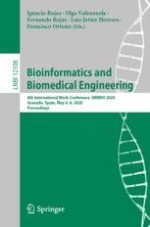This volume constitutes the proceedings of the 8th International Work-Conference on IWBBIO 2020, held in Granada, Spain, in May 2020.
The total of 73papers presented in the proceedings, was carefully reviewed and selected from 241 submissions. The papers are organized in topical sections as follows: Biomarker Identification; Biomedical Engineering; Biomedical Signal Analysis; Bio-Nanotechnology; Computational Approaches for Drug Design and Personalized Medicine; Computational Proteomics and Protein-Protein Interactions; Data Mining from UV/VIS/NIR Imaging and Spectrophotometry; E-Health Technology, Services and Applications; Evolving Towards Digital Twins in Healthcare (EDITH); High Performance in Bioinformatics; High-Throughput Genomics: Bioinformatic Tools and Medical Applications; Machine Learning in Bioinformatics; Medical Image Processing; Simulation and Visualization of Biological Systems.
